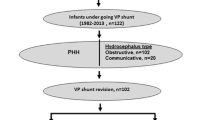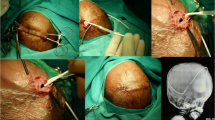Abstract
Purpose
Intraventricular hemorrhage is the most common cause of infantile acquired hydrocephalus. Our objective is to determine if the implantation of ventriculoperitoneal shunt in posthemorrhagic hydrocephalus as a primary and definitive neurosurgical treatment, with no previous temporary procedures, would decrease complication rates with good functional outcomes.
Methods
Two hundred seventy-one patients with germinal matrix hemorrhage were diagnosed at the Carlos Haya Hospital between 2003 and 2010. Forty-seven patients underwent ventriculoperitoneal shunt after developing symptomatic hydrocephalus. The minimum weight required for shunt implantation was 1,500 g. We recorded complications related to the surgical procedure and analyzed functional state with a self-developed four-grade scale.
Results
One hundred thirty-nine (51.3 %) patients with intraventricular hemorrhage developed ventricular dilatation, but only 47 patients (17.34 %) needed shunting. In seven cases, temporary neurosurgical procedures were performed, but in all of them, this was followed by ventriculoperitoneal shunt implantation. The infection rate was 4.25 %, and shunt obstruction rate was 4.25 %. More than 80 % of patients were classified as good or excellent functional state. Mean follow-up period was 38.75 months (SD, 27.09; range, 1–102 months).
Conclusions
Ventriculoperitoneal shunting as a primary neurosurgical treatment in posthemorrhagic hydrocephalus would decrease surgical morbidity with good functional outcome.


Similar content being viewed by others
References
Audeh S, Smolkin T, Bental Y, Haramati Z, Blazer S, Litig E, Biton R, Dolberg S, Makhoul IR (2011) Does admission hypothermia predispose to intraventricular hemorrhage in very-low-birth-weight infants? Neonatology 100(4):373–379
Ballabh P (2010) Intraventricular hemorrhage in premature infants: mechanism of disease. Pediatr Res 67:1–8
Bayley N (1993) Bayley scales of infant development II. Psychological Corp., San Antonio
Bayston R, Lambert E (1997) Duration of protective activity of cerebrospinal fluid shunt catheters impregnated with antimicrobial agents to prevent bacterial catheter-related infection. J Neurosurg 87(2):247–251
Bilguvar K, DiLuna ML, Bizzarro MJ, Bayri Y, Schneider KC, Lifton RP, Gunel M, Ment LR (2009) Pacifier and Breastfeeding Trial Group. COL4A1 mutation in preterm intraventricular hemorrhage. J Pediatr 155(5):743–745
Boop FA (2004) Posthemorrhagic Hydrocephalus of Prematurity. In: Cinalli G, Maixner WJ, Sainte-Rose C (eds) Pediatric hydrocephalus. Springer, Milan, pp 121–131
Boynton BR, Boynton CA, Merritt TA, Vaucher YE, James HE, Bejar RF (1986) Ventriculoperitoneal shunts in low birth weight infants with intracranial hemorrhage: neurodevelopmental outcome. Neurosurgery 18(2):141–145
Cinalli G (1999) Alternatives to shunting. Childs Nerv Syst 15(11–12):718–731
Duncan CC, Ment LR (1993) Intraventricular hemorrhage and prematurity. Neurosurg Clin N Am 4(4):727–734
Folkerth RD (2011) Germinal matrix haemorrhage: destroying the brain’s building blocks. Brain 134(5):1261–1263
Fulmer BBMD, Grabb PAMD (2000) Neonatal ventriculosubgaleal shunts. Neurosurgery 47(1):80–84
Hudgins RJ, Boydston WR, Gilreath CL (1998) Treatment of posthemorrhagic hydrocephalus in the preterm infant with a ventricular access device. Pediatr Neurosurg 29(6):309–313
Januschek E, Machado LS, Steinthal B, Ulrich PT (2011) Posthemorrhagic hydrocephalus in very low birth weight infants—a new gentle surgical technique for external ventricular drainage. Childs Nerv Syst 27(6):991–994, Epub 2011 Mar 12
Kazan S, Güra A, Uçar T, Korkmaz E, Ongun H, Akyuz M (2005) Hydrocephalus after intraventricular hemorrhage in preterm and low-birth weight infants: analysis of associated risk factors for ventriculoperitoneal shunting. Surg Neurol 64(Suppl 2):S77–S81, discussion S81
Khodapanahandeh F, Khosravi N, Larijani T (2008) Risk factors for intraventricular hemorrhage in very low birth weight infants in Tehran, Iran. Turk J Pediatr 50(3):247–252
Klebermass-Schrehof K, Czaba C, Olischar M, Fuiko R, Waldhoer T, Rona Z, Pollak A, Weninger M (2012) Impact of low-grade intraventricular hemorrhage on long-term neurodevelopmental outcome in preterm infants. Childs Nerv Syst 28(12):2085–2092
Köksal V, Öktem S (2010) Ventriculosubgaleal shunt procedure and its long- term outcomes in premature infants with post-hemorrhagic hydrocephalus. Childs Nerv Syst 26(11):1505–1515, Epub 2010 Mar 19
Hudgins RJ (2001) Posthemorrhagic hydrocephalus of infancy. Neurosurg Clin N Am 12(4):743–751
Lam HP, Heilman CB (2009) Ventricular access device versus ventriculosubgaleal shunt in posthemorrhagic hydrocephalus associated with prematurity. J Matern Fetal Neonatal Med 22(11):1097–1101
Lee JY, Kim HS, Jung E, Kim ES, Shim GH, Lee HG, Lee JA, Choi CW, Kim EK, Kim BI, Choi JH (2010) Risk factors for intraventricular hemorrhage in premature infants. J Korean Med Sci 25(3):418–424
Lim LW, Volkodav OV (2009) Germinal matrix hemorrhage of prematurity: treatment approaches and outcomes in a single institutional review in the Ukraine. Pediatr Neurosurg 45(2):132–140, Epub 2009 Mar 21
Limbrick DD Jr, Mathur A, Johnston JM, Munro R, Sagar J, Inder T, Park TS, Leonard JL, Smyth MD (2010) Neurosurgical treatment of progressive posthemorrhagic ventricular dilation in preterm infants: a 10-year single- institution study. J Neurosurg Pediatr 6(3):224–230
Notarianni C, Vannemreddy P, Caldito G, Bollam P, Wylen E, Willis B, Nanda A (2009) Congenital hydrocephalus and ventriculoperitoneal shunts: influence of etiology and programmable shunts on revisions. J Neurosurg Pediatr 4(6):547–552
Papile LA, Burstein J, Burstein R, Koffler H (1978) Incidence and evolution of subependymal and intraventricular hemorrhage: a study of infants with birth weights less than 1,500 gm. J Pediatr 92(4):529–534
Peretta P, Ragazzi P, Carlino CF, Gaglini P, Cinalli G (2007) The role of Ommaya reservoir and endoscopic third ventriculostomy in the management of post-hemorrhagic hydrocephalus of prematurity. Childs Nerv Syst 23:765–771
Rahman S, Teo C, Morris W, Lao D, Boop FA (1995) Ventriculosubgaleal shunt: a treatment option for progressive posthemorrhagic hydrocephalus. Childs Nerv Syst 11:650–654
Richard E, Cinalli G, Assis D, Pierre-Kahn A, Lacaze-Masmonteil T (2001) Treatment of post-haemorrhage ventricular dilatation with an Ommaya’s reservoir: management and outcome of 64 preterm infants. Childs Nerv Syst 17(6):334–340
Ros-López B, Jaramillo-Dallimonti AM, De Miguel-Pueyo LS, Rodríguez- Barceló S, Domínguez-Páez M, Ibáñez-Botella G, Márquez-Márquez B, Arráez-Sánchez MA (2009) Ventricular haemorrhage in preterm neonates and posthemorrhagic hydrocephalus. Proposal of a management protocol based on early ventriculo-peritoneal shunt. Neurocirugia (Astur) 20(1):15–24
Ros B, Romero L, Ibáñez G, Iglesias S, Rius F, Pérez S, Arráez MA (2012) Success criteria in pediatric neuroendoscopic procedures. Proposal for classification of results after 67 operations. Childs Nerv Syst 28(5):691–697, Epub 2012 Mar 14
Sciubba DM, Stuart RM, McGirt MJ, Woodworth GF, Samdani A, Carson B, Jallo GI (2005) Effect of antibiotic-impregnated shunt catheters in decreasing the incidence of shunt infection in the treatment of hydrocephalus. J Neurosurg 103(2 Suppl):131–136
Shooman D, Portess H, Sparrow O (2009) A review of the current treatment methods for posthaemorrhagic hydrocephalus of infants. Cerebrospinal Fluid Res 30(6):1
Sklar F, Adegbite A, Shapiro K, Miller K (1992) Ventriculosub- galeal shunts: management of posthemorrhagic hydrocephalus in premature infants. Pediatr Neurosurg 18:263–265
Staykov D, Huttner HB, Struffert T, Ganslandt O, Doerfler A, Schwab S, Bardutzky J (2009) Intraventricular fibrinolysis and lumbar drainage for ventricular hemorrhage. Stroke 40(10):3275–3280, Epub 2009 Aug 13
Taylor AG, Peter JC (2001) Advantages of delayed VP shunting in posthaemorrgagic hydrocephalus seen in low-weight infants. Childs Nerv Syst 17(6):328–333
Tubbs RS, Smyth MD, Wellons JC, Blount JP, Grabb PA, Oakes WJ (2003) Life #expectancy of ventriculosubgaleal shunt revisions. Pediatr Neurosurg 38:244–246
Tsitouras V, Sgouros S (2011) Infantile posthemorrhagic hydrocephalus. Childs Nerv Syst 27(10):1595–1608
Ventriculomegaly Trial Group (1990) Randomised trial of early tapping in neonatal posthaemorrhagic ventricular dilatation. Arch Dis Child 65:3–10
Ventriculomegaly Trial Group (1994) Randomised trial of early tapping in neonatal posthaemorrhagic ventricular dilatation: results at 30 months. Arch Dis Child 70:F129–F136
Vinchon M, Lapeyre F, Duquennoy C, Dhellemmes P (2001) Early treatment of posthemorrhagic hydrocephalus in low-birth-weight infants with valveless ventriculoperitoneal shunts. Pediatr Neurosurg 35(6):299–304
Wellons JC, Shannon CN, Kulkarni AV, Simon TD, Riva-Cambrim J, Whitehead WE (2009) A multicenter retrospective comparison of conversion from temporary to permanent cerebrospinal fluid diversion in very low birth weight infants with posthemorrhagic hydrocephalus. J Neurosurg Pediatr 4:50–55
Wigglesworth JS, Pape KE (1980) Pathophysiology of intracranial haemorrhage in the newborn. J Perinat Med 8(3):119–133
Willis BK, Kumar CR, Wylen EC, Nanda A (2005) Ventriculosubgaleal shunts for posthemorrhagic hydrocephalus in premature infants. Pediatr Neurosurg 41:178–185
Whitelaw A (2001) Repeated lumbar or ventricular punctures in newborns with intraventricular hemorrhage. Cochrane Database Syst Rev 1, CD000216
Whitelaw A (2001) Intraventricular haemorrhage and posthaemorrhagic hydrocephalus: pathogenesis, prevention and future interventions. Semin Neonatol 6(2):135–146
Whitelaw A, Thoresen M, Pople I (2002) Posthaemorrhagic ventricular dilatation. Arch Dis Child Fetal Neonatal Ed 86(2):F72–F74
Whitelaw A, Evans D, Carter M (2007) Randomized clinical trial of prevention of hydrocephalus after intraventricular hemorrhage in preterm infants: brain-washing versus tapping fluid. Pediatrics 119(5):1071–1078
Author information
Authors and Affiliations
Corresponding author
Rights and permissions
About this article
Cite this article
Romero, L., Ros, B., Ríus, F. et al. Ventriculoperitoneal shunt as a primary neurosurgical procedure in newborn posthemorrhagic hydrocephalus: report of a series of 47 shunted patients. Childs Nerv Syst 30, 91–97 (2014). https://doi.org/10.1007/s00381-013-2177-6
Received:
Accepted:
Published:
Issue Date:
DOI: https://doi.org/10.1007/s00381-013-2177-6




